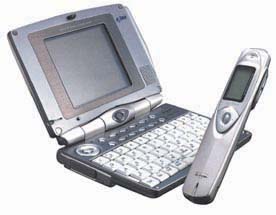 * 3G Gets Real -- FOMA PDA Hits the Streets * 3G Gets Real -- FOMA PDA Hits the Streets
NTT DoCoMo has released the SH2101V (JPY125,000), a PDA device with a video phone designed for FOMA. With a compact (43g) wireless handset, SH2101V users can have phone conversations even when the PDA is folded. The main unit and the handset are connected via Bluetooth and the handset is equipped with a small LCD display, which lets you check email messages or play music from the display. The SH2101V is the first FOMA device to support the video distribution service, M-Stage visual, which has been available only on PHS until now.
Source: www.nikkeibp.asiabiztech.com/wcs/frm/leaf?CID=onair/asabt/cover/195693
*** COMMENTARY: This is the first example of a PDA terminal for 3G and is interesting because it provides access to existing (2G) content -- the video clips provided until now only via M-Stage Visual on PHS. Why do we need a 3G terminal to access 2G content? Oh well...
This lends support to rumors we've heard that DoCoMo is having a tough time engineering a dual-mode PDC/W-CDMA terminal due to power and other tech requirements. Presumably, this PDA's battery is larger and more robust than what a simple (and much smaller) cellphone could accommodate. Continuous standby time is 60 hours for the main unit and 80 hours for the handset.
The SH2101V also allows access to i-mode, i-Appli (Java) and the FOMA video clip download service (i-motion); it also has a camera (no surprise here -- Big D now has four 2G devices that are equipped with a camera). The SH2101V can videoconference with P2101V and D2101V handsets as well as with the Lookwalk PHS.
DoCoMo is clearly keen to establish any sort of dual-mode technology that it possibly can in order to boost FOMA usage. You can also get a steep discount if you have a 2G PDC handset and you agree to buy a 3G FOMA handset, keeping the PDC model for voice calling and using the FOMA model for data. We guess this provides a 'virtual' dual-mode.
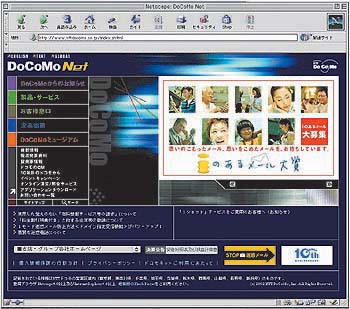 * DoCoMo, KPN Target 1m i-mode Subs in Europe by End of 2003
* DoCoMo, KPN Target 1m i-mode Subs in Europe by End of 2003
NTT DoCoMo aims to increase the number of European i-mode subscribers to 1 million by the end of next year. DoCoMo will operate through associate KPN Mobile NV of the Netherlands and KPN's subsidiaries, releasing handset models with built-in digital cameras. It started the i-mode service in the Netherlands in April this year and its German subsidiary, E-Plus, began offering the service in March. Base, its Belgian unit, plans to offer the service this autumn. Only one i-mode-compatible model is now available in the Netherlands and Germany. A model with built-in game-enabling software will be launched at the end of the year and a model with a built-in camera will be rolled out in early January.
Source: www.ananova.com/business/story/sm_627243.html?menu=business.latestheadlines
*** COMMENTARY: There were some 60,000 i-mode users in Germany and Holland as of the end of June and the service appears to be unfolding nicely, if a little slow. The most important metric is the 200-plus content, application and service providers, indicating that a solid base of third parties believes they can make money on the i-mode brand. Further, the proven success of camera-equipped phones and the fact that the current NEC i-mode handsets are pretty attractive (great color screens, good tones) should attract even more subscribers.
E-Plus, the German KPN partner, for one, is not forgetting about the marketing, either -- data costs are modest. One E-Plus brochure states that it costs about 0.07 euros to access a sports news story with a picture, 0.14 euros to download an image, 0.03 euros to receive a mail and 0.22 euros to send. A final challenge will be persuading the market to go for more lively games.
One Europe-based Java developer said, "Europeans are not accustomed to mobile gaming." Carriers are starting with simple stuff, like Tic Tac Toe. We think folks will learn real fast once Java is available on i-mode (next year?).
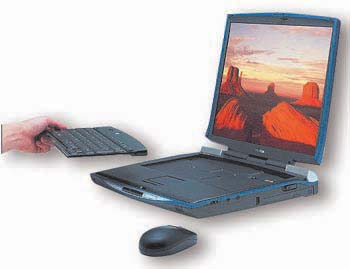 * Toshiba DynaBook P5/S24PME
* Toshiba DynaBook P5/S24PME
A 2.4GHz P4 notebook with a GeForce 4 440 graphics card, the P5/S24PME (JPY350,000) is no doubt a powerhouse of a portable PC. The whizz-bang gadgety aspect here is that the keyboard comes right out of the notebook's surround and can be used wirelessly! And, once wrenched clear of its housing, it will keep on going for up to 20 days. There's a wireless mouse included with the notebook too and they'll both operate up to 1m away from the main unit. How cool is that? Alternatively, how useful is that? Other specs in case, for some unearthly reason, the detachable wireless keyboard hasn't made you immediately rush online and reserve one, are, a 16in SXGA (1280 x 1024) TFT display, 256MB of RAM, a 40GB hard disk, a jack-of-all-trades DVD-CD-RW combi drive and a floppy disk drive for the more Luddite-inclined. The laptop runs Windows XP Home Edition and weighs 4.4kg.
More info: www.toshiba.co.jp
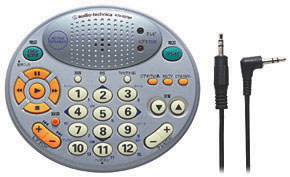 * Audio Technica ATV-527SP
* Audio Technica ATV-527SP
Of course, a remote control unit shaped like a UFO with a built-in 20mW speaker and headphone capability! How did we ever live without it? Well, we'll never have to find out, now, thanks to the ATV-527SP (JPY3,000) from Audio Technica. Good for controlling your TV, DVD and VTR all at the same time -- not simultaneously, obviously, but all with just the one unit. Oh, hang on: The speaker is for relaying the sounds from your TV to where you're sitting up to five meters away on the sofa. Makes sense, maybe, if you're getting on and slightly hard of hearing. And AT even claims you can use it with your PlayStation 2 but woefully neglects to say whether it'll work with your Xbox or 'Q' GameCube too.
More info: www.audio-technica.co.jp
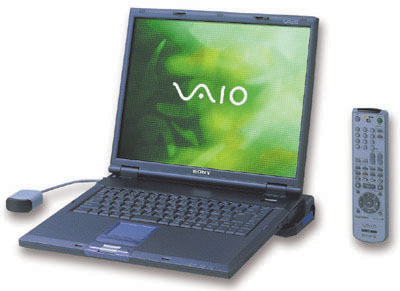 * Sony Vaio PCG-GRX91G/P
* Sony Vaio PCG-GRX91G/P
Described as "aimed at the high-end notebook market" (no kidding!), the JPY450,000 PCG-GRX91G/P is a Sony Vaio notebook with a built-in DVD-RW drive. NOT CD-RW, but DVD, so now you can create your own DVDs, thanks to the drag-and-drop Simple DVD Maker software.
Other nice features include the trademark jog dial, in this case centrally located under the touchpad, more connection options than you can shake a stick at and a USB-connected, optical remote control. That super drive runs as a 16-speed CD-R, 10-speed CD-RW, 8-speed DVD ROM and 24-speed CD-ROM. The GRX91G/P is powered by a 2GHz Mobile Intel Pentium P4 chip and 512MB of RAM and has a 60-gig hard disk. It also has a 1600x1200 UXGA display, a 32MB Mobility Radeon 7500 video card and comes preloaded with Windows XP Professional. Battery life isn't too clever, though -- it's claimed to be from two to three (read "two") hours.
If that simply isn't enough for you, there's a separate port replicator with hardware M-PEG2 encoder and TV tuner packed in the box. But this is one of Sony's ultra sexy 'slim type' Vaios, so leave the replicator on your desk at home, otherwise you lose a massive number of cool points. Get yours only online from October.
More info: www.jp.sonystyle.com
* TDK CDMP1215 New Mojo Audio Player
So that's where Austin Powers' Mojo got to: TDK snaffled it and stuck it inside its new MP3 CD player. The CDMP1215 (JPY18,000) is really only an update of the CDMP1210 released last November and pretty much the extent of said update is the new inclusion of a remote control with an LCD panel. These are all the rage in Tokyo -- or at least most consumer electronics manufacturers believe they are -- but happily, disgruntled CDMP1210 owners will be able to buy the snazzy new remocon separately for JPY3,980. The specs of the CDMP1215 remain identical to its predecessor (8-320Kbps bit rate, VBR support and 10 hours of playback) and the only other change is a purely cosmetic one, changing the body color of the machine to a monotone silver (it was formerly silver and blue or silver and gray).
More info: www.tmac.tdk.co.jp
|
 * 3G Gets Real -- FOMA PDA Hits the Streets
* 3G Gets Real -- FOMA PDA Hits the Streets

 * DoCoMo, KPN Target 1m i-mode Subs in Europe by End of 2003
* DoCoMo, KPN Target 1m i-mode Subs in Europe by End of 2003 * Toshiba DynaBook P5/S24PME
* Toshiba DynaBook P5/S24PME * Audio Technica ATV-527SP
* Audio Technica ATV-527SP * Sony Vaio PCG-GRX91G/P
* Sony Vaio PCG-GRX91G/P



